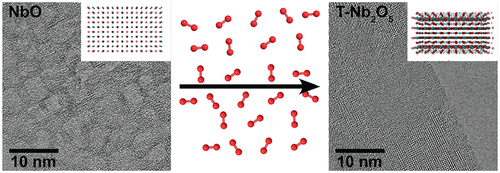当前位置:
X-MOL 学术
›
ACS Appl. Nano Mater.
›
论文详情
Our official English website, www.x-mol.net, welcomes your
feedback! (Note: you will need to create a separate account there.)
Atomic Resolution Observation of the Oxidation of Niobium Oxide Nanowires: Implications for Renewable Energy Applications
ACS Applied Nano Materials ( IF 5.3 ) Pub Date : 2020-09-02 , DOI: 10.1021/acsanm.0c01952 Sophia B. Betzler 1, 2, 3, 4 , Ai Leen Koh 1 , Bettina V. Lotsch 2, 3 , Robert Sinclair 1 , Christina Scheu 2
ACS Applied Nano Materials ( IF 5.3 ) Pub Date : 2020-09-02 , DOI: 10.1021/acsanm.0c01952 Sophia B. Betzler 1, 2, 3, 4 , Ai Leen Koh 1 , Bettina V. Lotsch 2, 3 , Robert Sinclair 1 , Christina Scheu 2
Affiliation

|
Niobium oxide exists in several crystal phases and valence states, yielding a variety of properties. Phase transitions between polymorphs significantly alter the properties of functional niobium oxide nanostructures, which are applied in many different renewable energy applications. This study uses environmental transmission electron microscopy to investigate the oxidation of NbO nanowires to T-Nb2O5. Small oxygen partial pressures (<1 mbar) suffice to initiate the oxidation which initially causes the destruction of the lattice ordering prior to the crystallization of the new phase. Different oxygen partial pressures and temperatures are used to manipulate the reaction kinetics. The crystallization is slow at room temperature and confined to the nanowire surface. Elevated temperatures accelerate the crystallization, resulting in the transformation of the complete nanowire. The transformation proceeds via dislocations, yielding the woven-like structure of the transformed nanowire. Despite the dramatic changes of the atomic composition of the material, an orientation relationship between the different phases is preserved. The phase transformation of NbO to T-Nb2O5 observed in situ complies with ex situ phase diagrams. This illustrates the importance of environmental transmission electron microscopy for the investigation of oxidation and reduction reactions of metal oxide nanostructures to identify the impact of shape and intrinsic defects.
中文翻译:

氧化铌纳米线氧化的原子分辨率观察:对可再生能源应用的启示
氧化铌以几种晶相和化合价态存在,产生各种特性。多晶型物之间的相变显着改变了功能性氧化铌纳米结构的特性,该特性已应用于许多不同的可再生能源应用中。这项研究使用环境透射电子显微镜研究了NbO纳米线氧化为T-Nb 2 O 5的过程。。较小的氧气分压(<1 mbar)足以引发氧化,这在新相结晶之前先引起晶格有序破坏。使用不同的氧气分压和温度来控制反应动力学。在室温下结晶是缓慢的,并局限于纳米线表面。升高的温度加速了结晶,导致整个纳米线的转变。转变通过位错进行,产生了转变后的纳米线的编织状结构。尽管材料的原子组成发生了巨大变化,但仍保留了不同相之间的取向关系。观察到NbO向T-Nb 2 O 5的相变原位符合异位相图。这说明了环境透射电子显微镜对于研究金属氧化物纳米结构的氧化和还原反应以识别形状和固有缺陷的影响的重要性。
更新日期:2020-09-25
中文翻译:

氧化铌纳米线氧化的原子分辨率观察:对可再生能源应用的启示
氧化铌以几种晶相和化合价态存在,产生各种特性。多晶型物之间的相变显着改变了功能性氧化铌纳米结构的特性,该特性已应用于许多不同的可再生能源应用中。这项研究使用环境透射电子显微镜研究了NbO纳米线氧化为T-Nb 2 O 5的过程。。较小的氧气分压(<1 mbar)足以引发氧化,这在新相结晶之前先引起晶格有序破坏。使用不同的氧气分压和温度来控制反应动力学。在室温下结晶是缓慢的,并局限于纳米线表面。升高的温度加速了结晶,导致整个纳米线的转变。转变通过位错进行,产生了转变后的纳米线的编织状结构。尽管材料的原子组成发生了巨大变化,但仍保留了不同相之间的取向关系。观察到NbO向T-Nb 2 O 5的相变原位符合异位相图。这说明了环境透射电子显微镜对于研究金属氧化物纳米结构的氧化和还原反应以识别形状和固有缺陷的影响的重要性。











































 京公网安备 11010802027423号
京公网安备 11010802027423号